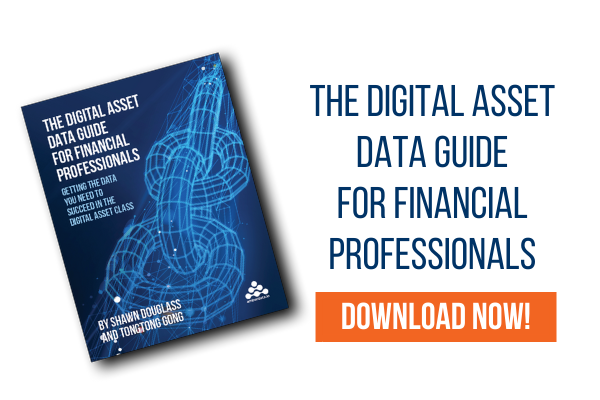3 Key Themes: S3 Air Summit 6.0’s Institutional Innovation Panel

At last month’s 2022 S3 AIR Summit in New York, Amberdata co-founder and CEO, Shawn Douglass, led a discussion titled “Innovation Panel: Institutional Perspectives On Blockchain And Digital Assets.”
Panel Members Rajeev Samyal (Director, Digital Assets and Advanced Solutions at BNY Mellon), Sandy Kaul (Senior Vice President, Franklin Templeton Investments), Will Peck (Head of Digital Assets at Wisdom Tree Asset Management), and Tracy Moors (Director Americas, Digital Asset) spent about 45 minutes discussing trends and opportunities for institutions within the digital asset space.
Here are 3 key themes they discussed:
Asset Tokenization
One consistent theme brought up by all panel members during the discussion was the development of new use cases beyond holding cryptocurrencies in portfolios. One major use case with significant institutional interest is tokenization. Sandy Kaul highlighted two opportunities:
Creating Liquidity for Illiquid Assets
"There are key areas that we're going to see the potential of these new technologies take hold. I think the first is going to be creating liquidity around illiquid assets. Many of us hold illiquid assets in our portfolio (real assets, LP shares) and these things are very difficult to create liquidity around. Even with the secondary markets, these are not optimal exit vehicles. It doesn't give us the option of how to add liquidity to the portfolio. So I think that these new tokenized structures can create that liquidity around previously illiquid assets and it can create new marketplaces to exchange that liquidity. We can even start to democratize the distribution of that liquidity to a far broader investor base, which will help to diversify portfolios at a tier where we don't create that diversification today."
Portfolio Utility
"Another key area is around utility. We are not used to thinking about what our investment portfolio does for us (other than making money). Tokenized digital assets are going to be created with a smart contract at the core of them. You can program in utilization rights and you can program in transferability rights. You will see far more people looking at their portfolio asking - what does my portfolio do for me? Does my portfolio facilitate my life? You can see people almost combining loyalty programs and investing, almost combining incentivized programs. I like to talk about here in New York, if you live in Brooklyn, if New York City wants to put tolls on the Brooklyn bridge, they could raise the money to do that by giving a token offering for the Brooklyn Bridge. If you're a token holder when your cargo is across the bridge, you can have a special owner's lane that only the owners of the Brooklyn Bridge can utilize. Think about how much convenience that might add to your life if you were living in Brooklyn and having to commute to the city every day."
Digital Identity Verification
Tracy Moors talked about new concepts in digital identity - making it easier for institutions to participate in DeFi.
"Because a lot of this started with the ethos of people that were kind of anti-authoritarian in that they didn't want institutions participating - now you're seeing a real tension starting to emerge. There are many projects and many protocols that today are very much looking to build in some of the controls that we, as institutions, would want to see in any investment landscape that we get into. Some interesting new concepts are coming out, concepts around going onto only networks where people are agreeing to self-certify - digital identity verification. There are some really interesting new pilots emerging around digital identity verification. Without exposing your identity, you can get your identity verified almost like Paypal will let you use your debit cards. There are going to be centralized services that will verify your identity to allow you to engage in certain protocols and transactions. So we're starting to see the space itself build in some new capabilities that will make it easier for institutions to participate."
NFTs
Shawn Douglass added his thoughts on NFTs and their use case as a customer loyalty tool.
"The whole concept of an NFT is simply a mechanism for digital rights management and even the capturing of annuity streams from those digital assets, it's profound. But when you start to look at the loyalty points programs that are happening with Adidas and Nike and every major brand, record label, and a lot of the sports labels, they get it, they are leaning in. There is an opportunity to build lifelong relationships with their customer base that they can't get through any other loyalty program that has incentives, gains momentum, and snowballs over time."
Institutional investors need to have their curiosity in place and start to think about where they bring these benefits into their business.
Key Session Takeaway
Douglass closed the session with the message that “digital assets are just the financialization of the internet. This will touch every business, every person in the world,” suggesting that financial professionals “get your toe in the water or you're going to miss out.”
And if you’re a financial professional at an institution that’s looking to “get your toe in the water”, the first thing you need is a primer on the data you will need to get started. Begin by downloading our e-book, “The Digital Asset Data Guide for Financial Professionals,” to learn more about digital asset data, why it is important, and why you need a source you can trust.
Amberdata
Amberdata is the leading provider of global financial infrastructure for digital assets. Our institutional-grade solutions deliver data, analytics and comprehensive tools and insights that empower financial institutions to research, trade, and manage risk and compliance in digital assets. Amberdata serves as a...
